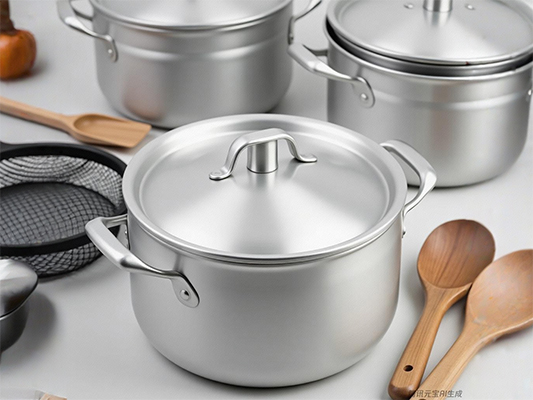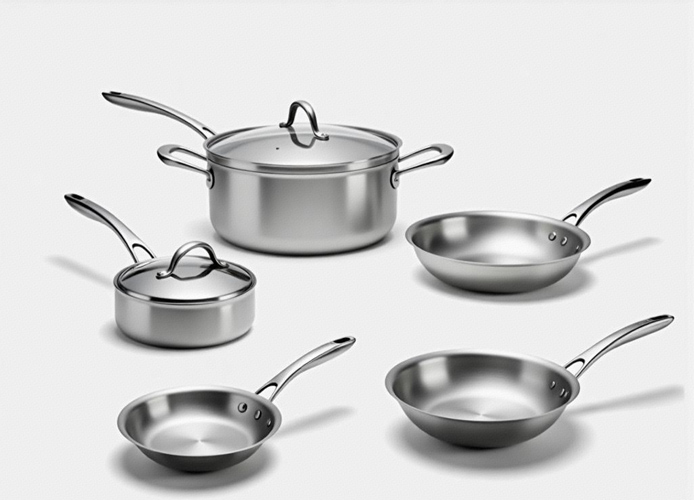When it comes to equipping your kitchen, choosing the right cookware is one of the most impactful decisions you’ll make. The material of your pots and pans influences not only how your food cooks but also the flavor, safety, durability, and ease of maintenance. Among the most popular choices are aluminum and stainless steel, each offering distinct advantages and drawbacks. In this detailed guide, we’ll dive deep into these two materials, providing you with the knowledge to make an informed decision. As a leading stainless steel cookware supplier from China, Inoxicon brings expert insights to help you select the best tools for your culinary adventures.
Why Cookware Material Matters
Cookware isn’t just a container—it’s a critical partner in your cooking process. The material determines how heat spreads across the surface, how food interacts with it, and how long it will serve you. For example, a material that conducts heat well can eliminate hot spots that burn your meal, while a non-reactive surface preserves the natural flavors of your ingredients without metallic interference. Durability is another key factor—high-quality cookware can withstand years of use, saving you money and effort over time. By understanding these properties, you can optimize your kitchen for efficiency, safety, and enjoyment, whether you’re a novice cook or a seasoned chef.
Aluminum Cookware: An In-Depth Look

Aluminum cookware has earned its place in kitchens around the globe thanks to its unique characteristics. Let’s explore what makes it special, along with its potential limitations.
Advantages of Aluminum Cookware
- Superior Heat Conductivity: Aluminum heats up quickly and distributes heat evenly, making it a top choice for tasks requiring precise temperature control. Whether you’re sautéing vegetables or preparing a delicate sauce, its thermal efficiency helps prevent uneven cooking and burnt spots.
- Lightweight Design: One of aluminum’s standout features is its low weight. This makes it easy to lift and maneuver, ideal for flipping pancakes or tossing stir-fries. For cooks with limited strength or small kitchens, this portability is a significant advantage.
- Affordable Price Point: Aluminum cookware is typically budget-friendly, offering excellent performance without breaking the bank. It’s a great option for beginners or anyone setting up a kitchen on a budget.
Disadvantages of Aluminum Cookware
- Reactivity with Foods: Aluminum can react with acidic or alkaline ingredients—like tomatoes, citrus, or vinegar—potentially altering the taste of your dish and causing pitting or discoloration in the cookware. Coatings like anodization or non-stick layers mitigate this, but uncoated aluminum remains vulnerable.
- Durability Limitations: As a softer metal, aluminum is susceptible to scratches, dents, and warping, especially under high heat or rough use. This can compromise both its appearance and functionality over time.
- Health Concerns: Though modern coatings reduce the risk, some worry about aluminum leaching into food. Research indicates this is minimal with anodized or non-stick versions, but it’s a consideration for those prioritizing health safety.
Types of Aluminum Cookware
- Anodized Aluminum: Treated through an electrochemical process, anodized aluminum is harder, more durable, and less reactive than its untreated counterpart. It’s a versatile choice for those seeking aluminum’s benefits with added resilience.
- Non-Stick Aluminum: Featuring a non-stick coating, this type excels at low-fat cooking and easy cleanup. However, the coating may wear off over time, necessitating replacement.
- Cast Aluminum: Thicker and more robust, cast aluminum retains heat well and is often used for bakeware or heavy-duty items like Dutch ovens.
Best Uses for Aluminum Cookware
Aluminum shines in situations where fast, even heating is key, and durability isn’t the primary concern. It’s perfect for quick meals like omelets, stir-fries, or reheating leftovers. However, for recipes involving acidic ingredients or long cooking times, you might want to consider alternatives.
Stainless Steel Cookware: An In-Depth Look

Stainless steel is a kitchen staple renowned for its strength and versatility. As specialists in this material, Inoxicon offers premium cookware designed to meet the demands of modern cooking.
Advantages of Stainless Steel Cookware
- Exceptional Durability: Made from a blend of metals like chromium and nickel, stainless steel resists rust, corrosion, and tarnish. With proper care, it can last decades, making it a favorite for both home and professional kitchens.
- Non-Reactive Properties: Stainless steel won’t interact with acidic or alkaline foods, ensuring your dishes taste pure and untainted. It’s a safe choice for everything from tomato sauces to citrus marinades.
- High Heat Resistance: Capable of withstanding intense temperatures without warping, stainless steel is perfect for searing, browning, or oven cooking. Its resilience under stress highlights its superior construction.
- Easy Maintenance: Stainless steel cleans up effortlessly, often safe for the dishwasher, and resists staining. A quick polish can keep it looking pristine even after heavy use.
Disadvantages of Stainless Steel Cookware
- Heat Conductivity: Pure stainless steel isn’t the best heat conductor, which can result in uneven cooking. However, premium options—like Inoxicon’s multi-layer designs—incorporate an aluminum or copper core to enhance performance.
- Heavier Weight: Stainless steel is denser than aluminum, offering stability but potentially feeling bulky for some users, especially with larger pieces.
- Higher Cost: Reflecting its durability and advanced construction, stainless steel typically costs more upfront. Yet, its longevity often justifies the investment.
Grades of Stainless Steel
- 18/10 Stainless Steel: The industry benchmark, with 18% chromium for corrosion resistance and 10% nickel for strength and shine. Inoxicon uses this grade to deliver top-quality cookware.
- 18/0 Stainless Steel: Containing 18% chromium but no nickel, this grade is more affordable but less durable. It’s common in budget cookware but lacks the premium feel of 18/10.
- Multi-Layer Construction: High-end stainless steel often features a core of aluminum or copper sandwiched between steel layers, combining durability with excellent heat distribution.
Best Uses for Stainless Steel Cookware
Stainless steel is a kitchen all-rounder, ideal for searing meats, simmering sauces, boiling pasta, or baking. Its versatility and toughness make it a go-to for cooks who value reliability and long-term performance.
Aluminum vs. Stainless Steel: A Side-by-Side Comparison
Here’s a clear comparison to highlight the differences between these materials:
| Aspect | Aluminum Cookware | Stainless Steel Cookware |
|---|---|---|
| Heat Conductivity | Excellent; fast and even heating | Moderate; enhanced with a core |
| Weight | Lightweight; easy to handle | Heavier; stable but less portable |
| Durability | Prone to scratches and warping | Highly durable; resists wear |
| Reactivity | Reacts with acidic/alkaline foods | Non-reactive; safe for all recipes |
| Maintenance | Requires careful handling | Easy to clean; dishwasher-friendly |
| Cost | Budget-friendly | Higher initial cost |
| Best For | Quick tasks, cost-conscious buyers | Long-term use, versatile cooking |
This breakdown shows the trade-offs: aluminum prioritizes speed and affordability, while stainless steel excels in durability and safety. Your choice depends on your specific needs and cooking habits.
Inoxicon’s Recommendation: Why Stainless Steel Stands Out
At Inoxicon, we advocate for stainless steel cookware because it offers a superior blend of performance and longevity. While aluminum is great for quick tasks or tight budgets, stainless steel addresses a broader range of needs with unmatched reliability.
Our cookware features multi-layer construction, integrating an aluminum or copper core to ensure even heating while retaining stainless steel’s strengths: durability, non-reactivity, and heat tolerance. This makes it ideal for everything from searing steaks to simmering sauces. Plus, with 18/10 stainless steel, our products are built to last a lifetime, offering exceptional value over time. For health-conscious cooks, the non-reactive surface provides peace of mind, ensuring your food remains safe and flavorful.
Choosing the Right Cookware for Your Needs
Your ideal cookware depends on your cooking style, budget, and priorities. Here’s how to decide:
- Quick, Casual Cooking: Aluminum is lightweight and affordable, perfect for fast tasks like frying eggs or reheating meals. Watch out for its reactivity and durability limits.
- Versatile, Long-Term Use: Stainless steel handles a wide range of techniques and lasts for years, making it ideal for frequent cooks or those seeking a lasting investment.
- Health and Safety: Stainless steel’s non-reactive nature makes it the best choice for avoiding chemical interactions with food.
- Budget Considerations: Aluminum offers solid performance at a lower cost, though it may need replacing sooner than stainless steel.
If you’re torn, try starting with a mix—perhaps an aluminum skillet for quick meals and a stainless steel pot for hearty dishes—to find your perfect fit.
Maintenance and Care Tips for Your Cookware
Proper care extends the life of your cookware, whether it’s aluminum or stainless steel. Here’s how to keep it in top shape:
Caring for Aluminum Cookware
- Limit High Heat: Use medium or low settings to prevent warping.
- Gentle Utensils: Stick to wooden, silicone, or plastic tools to avoid scratches, especially on non-stick surfaces.
- Hand Wash: While some pieces are dishwasher-safe, hand washing with mild soap preserves coatings and finishes.
Caring for Stainless Steel Cookware
- Preheat Correctly: Heat the pan before adding oil to minimize sticking.
- Clean Smart: Use baking soda and water for tough stains; avoid harsh scrubbers that could scratch.
- Dry Promptly: Prevent water spots by drying immediately after washing.
With these habits, your cookware will stay functional and attractive for years.
Conclusion: Elevate Your Kitchen with the Right Choice
Aluminum and stainless steel each bring something valuable to the table. Aluminum offers affordability and quick heating for casual cooking, while stainless steel provides durability, safety, and versatility for the long haul. At Inoxicon, we champion stainless steel as the ultimate choice for most kitchens, blending performance with practicality.
Ready to upgrade your cookware? Reach out to us at info@inoxiconkitchen.com or call to explore our stainless steel collection or get tailored advice. Your next culinary masterpiece deserves the best tools—let Inoxicon help you make it happen!